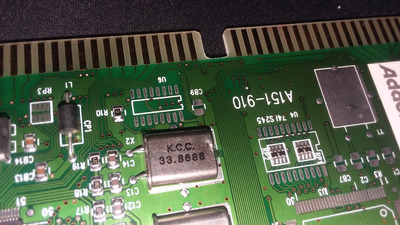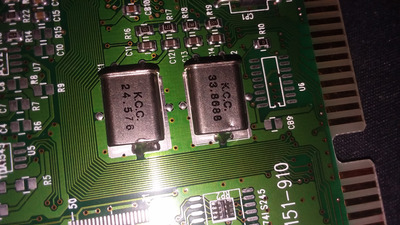First post, by athlon-power
- Rank
- Member
I know these cards are infamous for having issues, but I want to preface this with one thing:
There is a small dent on one of the oscillator crystals, that was not present in the photo on the eBay post. Either I did it, or it was done during shipping, but it's there now.
Anyways, the issues I've been having lie within IRQ conflicts, and Base I/O conflicts, specifically. I have an ISA 3Com Etherlink 3c509-B installed with it, as well as a PCI STB Velocity Nitro 3D 4MB on a Gateway 2000 P5 200 (Intel 430TX Chipset)
The resource conflicts went just beyond the IDE initially, but I was able to correct some of them while messing around with them in Windows. The wave and MIDI sound works just fine, so I don't think the crystal is doing anything to those if it has been damaged. The resource conflicts in detail:
The card conflicting with itself:
YAMAHA OPL3-SAx Reserved conflicts with YAMAHA OPL3-SAx Sound System at an I/O value of 0100-0107. Resolved by moving the I/O value to 0108-010F.
And the real king of problems here:
YAMAHA OPL3-SAx IDE conflicts with Standard PCI Graphics Adapter (VGA) and IRQ Holder for PCI Steering at IRQ 11.
YAMAHA OPL3-SAx IDE conflicts with Intel(r) 82371AB/EB PCI to USB Universal Host Controller and IRA Holder for PCI Steering at IRQ 10.
Additionally, any IRQ's I enter that are not 10 or 11 are rejected, I have tried everything. I have also set BIOS to non PnP OS, which changed nothing, and then a special setting called "ICU," which also did nothing.
Before I really messed around with it, it also conflicted with the PCI Bus Master for IDE and the Intel IDE controller. Not sure what I did to fix that as that went away suddenly after I did something (can't remember what) and they were replaced with the PCI Steering and USB. I have not installed video drivers yet, as that would be pretty pointless at this stage. The IDE is completely disabled in the SETUPSA configuration utility, so why it's still popping up is unbeknownst to me. Also, damn you Addonics, could you not have at least put a jumper to disable the IDE?! Not everybody is going to need that!
I think this is a result of me damaging that oscillator crystal and not knowing. In any case, I have thrown US$30 down the drain (not surprising to me at this point), like I do with ~75% of the vintage hardware I get these days that works perfectly fine until I own it.
Where am I?

